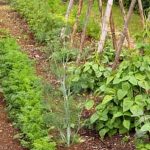What flowers are best for vegetable gardens? When it comes to creating a thriving vegetable garden, companion planting with flowers can play a crucial role in maximizing the overall productivity and health of the garden. In this article, we will explore the benefits of integrating flowers into vegetable gardens, factors to consider when choosing the right flowers, top flower recommendations, companion planting tips, common mistakes to avoid, and success stories of successful flower and vegetable garden combinations.
Planting flowers alongside vegetables is not just visually appealing – it also serves several practical purposes. Flowers attract beneficial insects that help control pests and pollinate crops, improve soil health by adding organic matter and nutrients, as well as enhance the overall aesthetic of the garden. The synergistic relationship between flowers and vegetables creates a balanced ecosystem that promotes growth and resilience within the garden.
When selecting flowers for a vegetable garden, there are several important factors to consider such as bloom time, height (to avoid overshadowing certain vegetables), and compatibility with specific types of vegetables. By understanding these factors and strategically planning the layout of flowers within your garden, you can maximize their benefits while avoiding potential pitfalls. In the following sections, we will delve deeper into these considerations and provide expert advice on how to successfully integrate flowers into vegetable gardens.
Benefits of Planting Flowers in Vegetable Gardens
Planting flowers in vegetable gardens offers a multitude of benefits that can significantly improve the overall health and productivity of the garden. One of the most important benefits is the ability of flowers to attract beneficial insects, such as bees, butterflies, and ladybugs. These insects play a crucial role in pollination and pest control, helping vegetables thrive and reducing the need for harmful chemical pesticides.
In addition to attracting beneficial insects, flowers also contribute to improving soil health in vegetable gardens. Certain types of flowers have deep root systems that can help break up compacted soil, improving drainage and allowing air and nutrients to reach the roots of vegetables more effectively. Furthermore, some flowers are known for their ability to add organic matter to the soil as they decompose, enriching it with essential nutrients for vegetable growth.
Not only do flowers offer practical benefits for vegetable gardens, but they also enhance the overall aesthetic appeal of the garden. By adding vibrant colors, textures, and heights, flowers create an inviting and visually pleasing environment that can transform a simple vegetable plot into a beautiful and productive space. Additionally, when strategically planted alongside vegetables, flowers can provide natural borders or barriers that help define different areas of the garden while creating a harmonious and balanced design.
Overall, planting flowers in vegetable gardens is a sustainable and natural way to support ecosystem health while also enhancing the beauty of your garden space. Consideration should be given to which types of flowers are best suited for your specific vegetables based on factors such as bloom time, height, compatibility with specific vegetables which will ensure optimal synergy between plants in your garden.
By choosing the right combination of flowers and vegetables according to these factors will result in an aesthetically pleasing as well as productive harvest season.
Factors to Consider When Choosing Flowers for Vegetable Gardens
When selecting flowers for your vegetable garden, it’s important to consider several key factors to ensure that they complement and enhance the growth of your vegetables. The right combination of flowers can not only attract beneficial insects but also improve soil health and contribute to the overall visual appeal of your garden.
One crucial factor to think about is the bloom time of the flowers. Different flowers bloom at different times of the year, so it’s essential to choose varieties that will provide a consistent source of nectar and pollen throughout the growing season. Planting a mix of early, mid, and late-blooming flowers will ensure a steady supply of pollinators and beneficial insects in your garden.
Another factor to consider is the height of the flowers. Taller flowers can provide shade and support for climbing vegetables like cucumbers or pole beans, while shorter flowers can fill in gaps between plants and act as ground cover. By strategically choosing flowers with varying heights, you can create a more dynamic and functional garden space.
Lastly, it’s crucial to choose flowers that are compatible with specific vegetables. Some flowers have allelopathic properties that can inhibit the growth of certain vegetables, while others may attract pests or compete for nutrients. Researching which flowers work best with your specific vegetable crops is essential in creating a harmonious and thriving garden environment.
When considering what flowers are best for vegetable gardens, keep these factors in mind to ensure that you select the most suitable varieties for your unique growing conditions. By paying attention to bloom time, height, and compatibility with specific vegetables, you can create a diverse and balanced garden that benefits both your plants and local wildlife.
Key Factors to Consider When Choosing Flowers for Vegetable Gardens
- Bloom time: Selecting varieties that bloom at different times throughout the growing season
- Height: Choosing a mix of taller and shorter flowers to provide support and ground cover
- Compatibility: Researching which flowers work best with specific vegetable crops
Top Flowers for Vegetable Gardens
When considering what flowers are best for vegetable gardens, it is important to choose varieties that not only enhance the beauty of the garden but also provide practical benefits to the vegetables being grown. Marigolds, nasturtiums, calendula, and sunflowers are some of the top choices for companion planting in vegetable gardens due to their ability to attract beneficial insects, improve soil health, and deter pests.
Marigolds are known for their vibrant blooms and their ability to repel harmful nematodes in the soil. Nasturtiums offer both edible flowers and leaves while attracting aphids away from vegetables like tomatoes and cucumbers.
Calendula, also known as pot marigold, has bright orange or yellow flowers that can be used in salads or as a natural dye for fabrics, all while attracting pollinators to the garden. Sunflowers not only add a pop of color to the garden but also provide height and support for climbing vegetables such as beans and peas.
When choosing which flowers to plant alongside vegetables, it is important to consider factors such as bloom time, height, and compatibility with specific vegetables. For example, taller flowers like sunflowers should be planted at the back of the garden so they do not shade smaller plants. Additionally, selecting flowers that bloom at different times throughout the growing season can ensure a continuous supply of nectar and pollen for beneficial insects.
Incorporating these top flowers into a vegetable garden can create a thriving ecosystem that supports both plant growth and beneficial insect populations. By strategically selecting and placing these flowers alongside vegetables, gardeners can experience improved yields and reduced pest pressures while enjoying a beautiful display of colors throughout the growing season.
| Flower | Specific Benefit |
|---|---|
| Marigolds | Repel harmful nematodes in the soil |
| Nasturtiums | Attract aphids away from other vegetables |
| Calendula | Attract pollinators while providing edible flowers |
| Sunflowers | Provide support for climbing vegetables like beans and peas |
Companion Planting Tips
When strategically planting flowers in a vegetable garden, there are several important considerations to keep in mind. One of the key factors to consider is the compatibility of the flowers with specific vegetables.
Certain flowers can provide benefits such as deterring pests or attracting beneficial insects, so it’s important to choose flowers that will complement the overall health and growth of the vegetable plants. Additionally, considering the bloom time and height of the flowers is crucial for ensuring they do not overshadow or inhibit the growth of the vegetables.
Another important tip for companion planting in vegetable gardens is to plant flowers that attract pollinators. Bees, butterflies, and other pollinators play a crucial role in fertilizing vegetable plants, ultimately leading to a higher yield. Flowers such as lavender, coneflowers, and bee balm are known to attract pollinators and can significantly improve the productivity of a vegetable garden.
It’s also beneficial to interplant flowers with different vegetable crops to create a diverse and balanced ecosystem within the garden. This can help reduce the risk of pests and diseases, improve soil health, and create an aesthetically pleasing environment. Careful consideration should be given to spatial arrangement when interplanting – taller flowers should be placed where they won’t shade smaller vegetables or inhibit their growth.
| Flower | Benefit |
|---|---|
| Marigolds | Natural pest control – repel nematodes |
| Nasturtiums | Attract aphids away from veggies |
| Calendula | Companion flower – attracts pollinators |
| Sunflowers | Provide shade for delicate vegetables |
Common Mistakes to Avoid
When it comes to planting flowers in vegetable gardens, there are certain mistakes that can be easily avoided with proper planning and knowledge. Avoiding these pitfalls will ensure that the flowers you choose will enhance the overall health and productivity of your vegetable garden.
One common mistake to avoid when planting flowers in vegetable gardens is not considering the specific needs of the vegetables and flowers being planted together. It’s important to choose flowers that are compatible with the particular vegetables in your garden. For example, tall or bushy flowers could potentially overshadow smaller vegetables, inhibiting their growth. Consider the height and spread of both the vegetables and flowers to ensure they can coexist harmoniously.
Another mistake to avoid is not paying attention to bloom time when selecting flowers for your vegetable garden. Planting flowers that bloom at the same time as your vegetables can attract beneficial insects when they are needed most. Additionally, choosing a variety of flowers with staggered bloom times can provide continuous support for pollinators and beneficial insects throughout the growing season.
Furthermore, overlooking the potential impact of invasive or aggressive flower species on your vegetable garden can be a significant mistake. Some flowering plants have vigorous growth habits that could potentially overwhelm your vegetable crops if not kept in check. Conducting research on the growth habits and potential invasiveness of different flower species before planting them alongside your vegetables is crucial.
- Consider the specific needs of both vegetables and flowers
- Pay attention to bloom time
- Research potential invasiveness of flower species
By taking these factors into consideration, you can avoid common mistakes when planting flowers in your vegetable garden and create a harmonious environment where both plants can thrive together.
Success Stories
The combination of flowers and vegetables in a garden can create a thriving and visually stunning space. Many gardeners have experienced success with this approach, and sharing real-life examples can inspire others to incorporate flowers into their own vegetable gardens. By exploring these success stories, readers can gain valuable insights into the benefits of companion planting and how to achieve similar results in their own gardens.
One successful example of flower and vegetable garden combinations is the use of marigolds alongside tomatoes. Marigolds not only add a pop of color to the garden, but they also act as natural pest repellents, protecting tomato plants from harmful insects. By strategically planting marigolds around tomato plants, gardeners can effectively deter pests without the need for chemical pesticides.
Another inspiring success story involves the pairing of nasturtiums with squash. Nasturtiums are known for their ability to attract pollinators, such as bees and butterflies, which play a crucial role in the pollination process for squash plants. This partnership not only enhances the overall health of squash plants but also contributes to a more vibrant and thriving garden ecosystem.
Before-and-after photos of these successful flower and vegetable garden combinations showcase the transformation that occurs when flowers are integrated into vegetable gardens. The visual impact of vibrant blooms alongside healthy vegetables demonstrates the powerful effect that companion planting can have on both the aesthetic appeal and overall productivity of a garden. These success stories serve as compelling evidence of what flowers are best for vegetable gardens and provide inspiration for gardeners looking to enhance their own growing spaces.
Conclusion
In conclusion, when it comes to the question of what flowers are best for vegetable gardens, the benefits of companion planting become clear. From attracting beneficial insects to improving soil health and enhancing the overall aesthetic of the garden, planting flowers alongside vegetables can significantly improve the success of your garden. When choosing flowers for your vegetable garden, it is important to consider factors such as bloom time, height, and compatibility with specific vegetables.
Some of the top flowers for vegetable gardens include marigolds, nasturtiums, calendula, and sunflowers. Marigolds are known for their pest-repelling properties, while nasturtiums attract predatory insects that feed on common garden pests. Calendula not only adds a pop of color but also has medicinal properties that can benefit both humans and plants. Sunflowers provide height and shade while also attracting pollinators to the garden.
To start incorporating flowers into your own vegetable garden, consider interplanting them throughout your vegetable beds or dedicating separate areas for flower patches within your garden. This strategic placement will maximize their benefits and create a harmonious balance between the two types of plants. Remember to avoid common mistakes such as overcrowding and choosing invasive species that could compete with your vegetables for resources.
By following these tips and experimenting with different combinations, you can create your own successful flower and vegetable garden combination and enjoy a thriving, beautiful garden all season long. Happy gardening.
Frequently Asked Questions
What Flowers Should I Put in a Vegetable Garden?
Flowers that can be beneficial to plant in a vegetable garden include marigolds, nasturtiums, and calendula. These flowers can attract pollinators, repel pest insects, and add beauty to the garden while also serving functional purposes.
What Flowers Should Not Be Planted With Vegetables?
Certain flowers should not be planted with vegetables due to their aggressive growth or potential to compete for nutrients. Examples of flowers that should be avoided in a vegetable garden include sunflowers, lavender, and lilies, as they can overshadow or hinder the growth of the vegetables.
What Plants to Plant Together in a Vegetable Garden?
Companion planting is a practice where certain plants are grown together to benefit each other. In a vegetable garden, some plants that can be planted together include tomatoes and basil, which complement each other’s flavors and repel pests. Additionally, carrots and onions can be planted together as they help deter pests and diseases when grown in close proximity.

If you’re looking to get into vegetable gardening, or are just looking for some tips on how to make your current garden better, then you’ve come to the right place! My name is Ethel and I have been gardening for years. In this blog, I’m going to share with you some of my best tips on how to create a successful vegetable garden.





